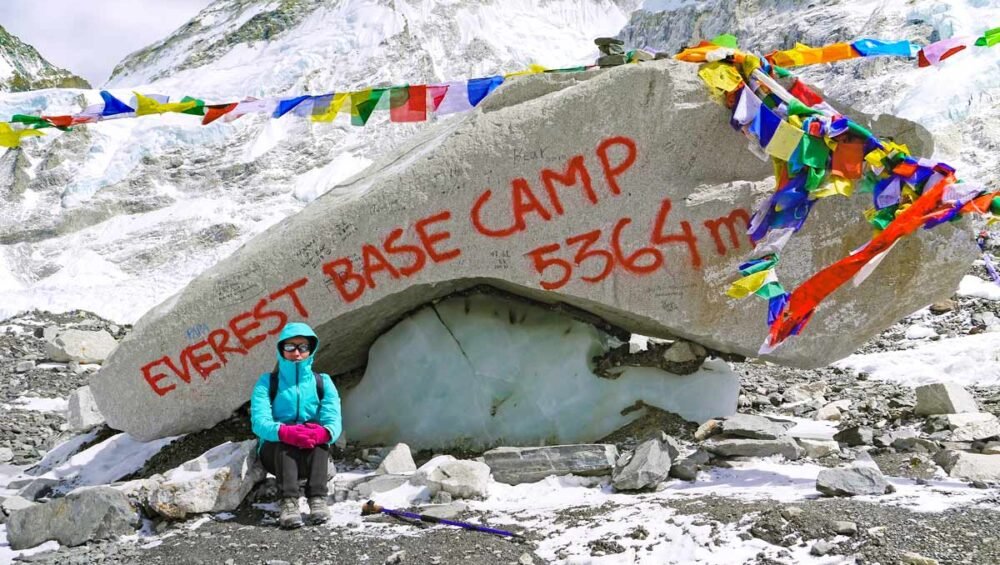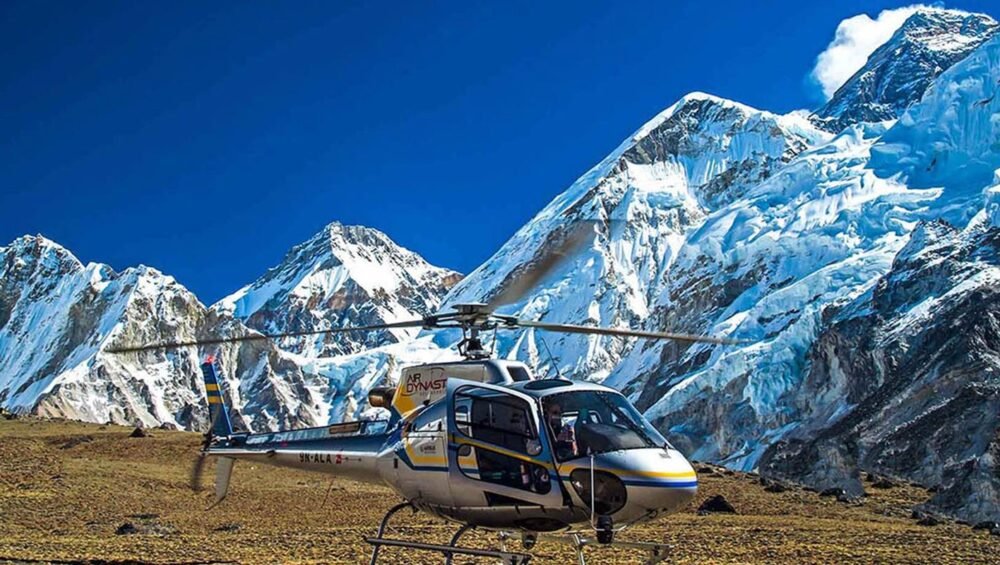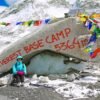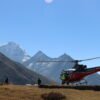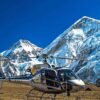Overview of the Tour
The Everest Base Camp Helicopter Tour offers an unparalleled opportunity to experience the majesty of the Himalayas and Mount Everest from the sky. This unique adventure allows travelers to bypass the strenuous trek and instead enjoy a bird’s eye view of the world's highest peaks. The tour typically involves a flight from Kathmandu to Everest Base Camp, with stops at various scenic and culturally significant spots along the way. The experience promises breathtaking views, unforgettable memories, and a deep appreciation for the natural beauty and cultural richness of the Everest region.
Why Choose a Helicopter Tour?
Opting for a helicopter tour to Everest Base Camp has several advantages over traditional trekking. The primary benefit is the time saved; what usually takes weeks of trekking can be condensed into a single day. This makes it accessible to those with limited time or physical limitations. Additionally, a helicopter tour provides a unique aerial perspective of the Himalayas, offering views that are impossible to achieve on foot. The comfort and convenience of helicopter travel also mean that participants can enjoy the beauty of Everest without the physical strain and risks associated with high-altitude trekking.
Benefits Over Traditional Trekking
- Time Efficiency: A helicopter tour is ideal for travelers with tight schedules, allowing them to experience Everest in a matter of hours rather than weeks.
- Comfort: Avoid the physical challenges and potential altitude sickness that come with trekking.
- Accessibility: Perfect for those who are unable to trek due to physical constraints.
- Unique Views: Enjoy unparalleled aerial views of Everest and the surrounding peaks, valleys, and glaciers.
- Safety: Reduced exposure to the risks associated with long treks, such as altitude sickness, extreme weather, and physical injuries.
Target Audience
The Everest Base Camp Helicopter Tour appeals to a diverse range of travelers. It is perfect for adventurers who want to experience the grandeur of Everest but lack the time or physical ability for a traditional trek. It also attracts luxury travelers seeking a unique and comfortable way to see the Himalayas, photographers and filmmakers looking for the best vantage points, and anyone with a deep interest in the natural and cultural heritage of Nepal.
History and Popularity of Everest Base Camp Tours
The Rise of Adventure Tourism
Adventure tourism has seen significant growth over the past few decades, driven by a global desire for unique and challenging experiences. The Himalayas, and Everest in particular, have become iconic destinations for adventurers seeking the ultimate challenge. The concept of adventure tourism encompasses a wide range of activities, from mountaineering and trekking to more recent innovations like helicopter tours.
Historical Milestones of Everest Expeditions
Everest has been a focal point for explorers since the early 20th century. The first successful ascent by Sir Edmund Hillary and Tenzing Norgay in 1953 marked a significant milestone in mountaineering history. This achievement spurred a wave of interest in Everest, leading to the development of various trekking routes and, eventually, the introduction of helicopter tours as a more accessible means to experience the mountain's grandeur.
Growth in Popularity of Helicopter Tours
In recent years, helicopter tours to Everest Base Camp have gained immense popularity. This growth can be attributed to advancements in aviation technology, increased interest in luxury travel, and the desire for unique experiences that can be shared on social media. The convenience and safety of helicopter tours have made them a preferred choice for many, contributing to their rising popularity.

Key Factors Driving Demand
Several factors drive the demand for Everest Base Camp Helicopter Tours:
- Accessibility: The ability to experience Everest without extensive physical exertion.
- Time Constraints: The efficiency of the tour fits into shorter travel schedules.
- Safety: Reduced risk compared to traditional trekking.
- Luxury and Comfort: The appeal of a comfortable and exclusive adventure.
- Social Media Influence: The desire to capture and share stunning aerial views of Everest.
Preparing for the Helicopter Tour
Physical and Mental Preparation
While the helicopter tour is less physically demanding than trekking, it still requires some preparation. Travelers should be in good health and comfortable with high altitudes. Mental readiness is also important, as the experience can be intense and overwhelming.
Required Documentation
Travelers need to ensure they have all necessary documentation, including a valid passport, visa for Nepal, and any required permits. It's advisable to check with the tour operator for specific documentation requirements.
Essential Gear and Packing List
Packing for a helicopter tour is straightforward but requires careful consideration:
- Clothing: Warm layers, as temperatures can drop significantly at higher altitudes.
- Footwear: Comfortable, sturdy shoes for any short walks at landing sites.
- Accessories: Sunglasses, gloves, and a hat to protect against sun and cold.
- Camera: To capture the stunning views.
- Personal Items: Any necessary medications, sunscreen, and snacks.
Health and Safety Precautions
Travelers should consult with their doctor about high-altitude travel and any necessary vaccinations. It's also important to stay hydrated and follow any safety guidelines provided by the tour operator.
The Route and Itinerary
Typical Itinerary Overview
A typical Everest Base Camp Helicopter Tour begins with a flight from Kathmandu, making stops at various points of interest before reaching Everest Base Camp. The tour usually includes a breakfast stop at a high-altitude lodge, time to explore the base camp area, and a return flight to Kathmandu.
Major Landmarks and Scenic Highlights
Key highlights of the tour include:
- Lukla: The gateway to the Everest region with its famous short runway.
- Namche Bazaar: A bustling Sherpa town with vibrant markets and stunning views.
- Tengboche Monastery: A spiritual center with panoramic mountain views.
- Everest Base Camp: The starting point for climbers, offering close-up views of Everest.
- Kala Patthar: A high-altitude viewpoint with some of the best views of Everest.
Key Stops Along the Way
In addition to the major landmarks, the tour may include stops at other scenic spots such as:
- Pheriche: A small village with a medical center.
- Gorak Shep: The last stop before Everest Base Camp.
- Khumbu Glacier: A massive glacier with stunning ice formations.
Expected Duration of the Tour
The entire tour typically lasts around 4 to 5 hours, including flight time and stops. This makes it a convenient option for travelers looking to make the most of their time in Nepal.
Experiencing the Everest Base Camp Helicopter Tour
Departure and Initial Flight
The adventure begins with a departure from Kathmandu, where travelers board the helicopter and receive a briefing on the flight and safety procedures. As the helicopter ascends, passengers can enjoy stunning aerial views of the Kathmandu Valley and the surrounding mountains.
Scenic Views and Photography Opportunities
The flight offers numerous opportunities for photography, with sweeping views of the Himalayan range. Passengers can capture the contrast between the lush valleys and the snow-capped peaks, as well as unique angles of Everest and its neighboring mountains.

Key Locations Visited
Throughout the tour, travelers will visit several key locations:
- Lukla: Known for its challenging airport, offering a thrilling landing experience.
- Namche Bazaar: A vibrant Sherpa town and a cultural hub in the Everest region.
- Everest Base Camp: The highlight of the tour, providing an up-close view of the world's highest peak.
- Kala Patthar: Offering the best panoramic views of Everest and the surrounding peaks.
Cultural Insights and Local Interactions
Along the way, travelers have the chance to interact with local Sherpas and learn about their culture and way of life. Stops at monasteries and villages provide insights into the spiritual and cultural heritage of the region.
Detailed Breakdown of the Helicopter Tour Cost
Average Pricing and Packages
The cost of an Everest Base Camp Helicopter Tour can vary depending on the tour operator, the inclusions, and the season. On average, prices range from $1,200 to $1,500 per person. Some operators offer group discounts or customized packages that include additional services such as accommodation and meals.
What’s Included in the Cost
Typically, the cost includes:
- Round-trip helicopter flight from Kathmandu to Everest Base Camp.
- Airport transfers.
- Permits and entry fees.
- Breakfast or refreshments at a high-altitude lodge.
- Professional guide and crew.
Optional Add-ons and Extra Costs
Travelers may choose to add on extra services such as:
- Photography or videography packages.
- Extended stays at high-altitude lodges.
- Customizable itineraries with additional stops.
- Travel insurance covering high-altitude travel.
Tips for Budgeting
To budget effectively for the tour:
- Compare different tour operators and their packages.
- Consider booking during the off-peak season for potential discounts.
- Factor in additional costs such as tips for the crew, personal expenses, and any optional add-ons.
Best Time to Take the Helicopter Tour
Seasonal Weather Considerations
The best time for an Everest Base Camp Helicopter Tour is during the pre-monsoon (March to May) and post-monsoon (September to November) seasons. During these times, the weather is generally clear, providing the best visibility for scenic views.
Peak Tourist Seasons
The peak tourist seasons coincide with the best weather conditions. However, this also means higher prices and more crowded landing spots. Booking in advance is recommended to secure a spot during these times.
Advantages of Off-Peak Travel
Traveling during the off-peak season (winter and monsoon) has its advantages, such as:
- Lower prices and potential discounts.
- Fewer crowds, offering a more private experience.
- Unique views of the region's changing landscapes.
Ideal Weather Conditions
Ideal weather conditions for the tour include clear skies, moderate temperatures, and minimal wind. These conditions enhance visibility and ensure a smooth and enjoyable flight.
Safety and Regulations
Helicopter Safety Standards
Helicopter tours in Nepal adhere to strict safety standards set by aviation authorities. Operators use well-maintained helicopters and experienced pilots trained in high-altitude flying.
Regulatory Requirements and Compliance
Tour operators must comply with regulations set by the Civil Aviation Authority of Nepal (CAAN). This includes obtaining necessary permits and adhering to safety protocols.
Emergency Procedures
In case of emergencies, helicopters are equipped with first aid kits and communication devices. Pilots and crew are trained to handle various scenarios, ensuring passenger safety at all times.
Tips for Ensuring a Safe Tour
- Choose a reputable tour operator with good reviews.
- Follow all safety instructions provided by the crew.
- Ensure you are in good health and prepared for high altitudes.
- Stay hydrated and dress appropriately for varying temperatures.
Environmental and Ethical Considerations
Impact on Local Communities
Helicopter tours can have both positive and negative impacts on local communities. While they provide economic benefits through tourism, there is also a risk of disrupting local life and culture. It's important for tour operators and travelers to be mindful of their impact and engage with communities respectfully.
Environmental Footprint of Helicopter Tours
Helicopter tours contribute to carbon emissions and can affect the pristine environment of the Everest region. Operators are encouraged to adopt eco-friendly practices and offset their carbon footprint.
Sustainable Tourism Practices
Promoting sustainable tourism practices involves:
- Minimizing waste and leaving no trace.
- Supporting local businesses and communities.
- Educating travelers about the environmental impact of their activities.
- Encouraging responsible behavior and respect for local culture and nature.
Supporting Local Economies
Travelers can support local economies by:
- Purchasing goods and services from local businesses.
- Staying at locally-owned accommodations.
- Engaging with community-based tourism initiatives.
Comparing Helicopter Tours with Other Trekking Options
Pros and Cons of Helicopter Tours
Pros:
- Time-efficient and less physically demanding.
- Unique aerial views of the Himalayas.
- Comfortable and convenient.
Cons:
- Higher cost compared to trekking.
- Limited interaction with the environment.
- Potential environmental impact.
Comparing Costs and Experiences
While helicopter tours are more expensive, they offer a different experience compared to trekking. Trekking allows for a deeper connection with the landscape and culture, while helicopter tours provide a quick and comfortable way to witness the beauty of Everest.
Physical Demands of Trekking vs. Helicopter Tours
Trekking to Everest Base Camp requires significant physical endurance and acclimatization to high altitudes. Helicopter tours, on the other hand, are suitable for travelers of all fitness levels and do not require extensive physical preparation.
Choosing the Best Option for Different Travelers
The best option depends on individual preferences and circumstances. Those seeking adventure and immersion might prefer trekking, while travelers looking for convenience and comfort might opt for a helicopter tour.
Real-Life Experiences and Testimonials
Stories from Past Tour Participants
Many travelers have shared their exhilarating experiences of the Everest Base Camp Helicopter Tour. They describe the awe-inspiring views, the thrill of flying over the Himalayas, and the sense of achievement upon reaching the base camp.
Memorable Moments and Highlights
Highlights often include the first sight of Everest, the landing at Kala Patthar, and the breathtaking views of the Khumbu Glacier. The cultural encounters and interactions with local Sherpas also leave a lasting impression.
Challenges Faced During the Tour
Challenges can include adjusting to high altitudes, dealing with weather changes, and ensuring proper documentation and permits. However, these are typically managed with the help of experienced tour operators.
Advice from Experienced Travelers
Experienced travelers recommend:
- Booking with reputable operators.
- Preparing adequately for high-altitude conditions.
- Bringing a good camera and plenty of storage space.
- Embracing the unique cultural and natural experiences.
Planning Your Everest Base Camp Helicopter Tour
Choosing the Right Tour Operator
Selecting a reliable tour operator is crucial for a successful experience. Look for operators with good reviews, experienced pilots, and comprehensive safety measures.
Booking Process and Tips
Booking can be done online through the operator's website or via travel agencies. It's advisable to book well in advance, especially during peak seasons. Compare different packages and read reviews to make an informed decision.
Customizing Your Tour
Many operators offer customizable itineraries. Travelers can add extra stops, extend their stay at high-altitude lodges, or include additional services such as guided tours and photography packages.
Preparing a Personal Checklist
Before the tour, ensure you have:
- All necessary documentation and permits.
- Appropriate clothing and gear.
- A well-charged camera and spare batteries.
- Personal items such as medications and snacks.
The Impact of COVID-19 on Helicopter Tours
Changes in Tour Operations
The COVID-19 pandemic has led to changes in how tours are operated, with increased health and safety protocols, reduced group sizes, and more flexible booking policies.
Health and Safety Protocols
Tour operators have implemented measures such as regular sanitization of helicopters, health screenings for passengers and crew, and mandatory mask-wearing.
Travel Restrictions and Guidelines
Travelers should stay updated on the latest travel restrictions and guidelines issued by the Nepalese government and health authorities. It's important to comply with all regulations to ensure a safe and smooth journey.
Future Outlook for Adventure Tourism
While the pandemic has temporarily affected tourism, the demand for adventure travel is expected to rebound. Helicopter tours to Everest Base Camp will continue to be a popular option, with operators adapting to new safety standards.
Cultural and Natural Highlights of the Region
Unique Cultural Experiences
The Everest region is rich in cultural heritage. Travelers can visit ancient monasteries, interact with local Sherpas, and participate in traditional ceremonies and festivals.
Flora and Fauna of the Everest Region
The region is home to diverse flora and fauna, including rare species such as the snow leopard, Himalayan tahr, and various high-altitude plants. The helicopter tour offers a chance to observe this unique biodiversity from above.
Geological Features and Landscapes
The tour showcases the dramatic geological features of the Himalayas, from towering peaks and deep valleys to massive glaciers and icefalls. The Khumbu Glacier and the Lhotse-Nuptse massif are particularly notable.
Local Festivals and Events
Travelers can experience local festivals such as the Mani Rimdu festival at Tengboche Monastery, which features colorful rituals, dances, and traditional music. These events provide a deeper understanding of the region's cultural and spiritual life.
Conclusion
Summary of Key Points
The Everest Base Camp Helicopter Tour offers a unique and thrilling way to experience the majesty of the Himalayas. From the breathtaking views to the rich cultural encounters, it is a journey that leaves a lasting impression.
Final Recommendations
Travelers are encouraged to prepare adequately, choose reputable tour operators, and embrace the adventure with an open mind and heart.
Encouragement for Potential Travelers
For those seeking a once-in-a-lifetime experience, the Everest Base Camp Helicopter Tour promises unparalleled views, cultural insights, and memories that will be cherished forever.
FAQs
How long is the Everest Base Camp Helicopter Tour?
The tour typically lasts between 3 to 5 hours, depending on weather conditions and the specific itinerary.
What should I wear on the tour?
Dress in layers to accommodate varying temperatures. Warm clothing, a hat, gloves, and sturdy shoes are recommended.
Is the helicopter tour safe for everyone?
The tour is generally safe for all, but individuals with severe health conditions should consult a doctor before participating.
What is the best time of year to take the tour?
The best times are during the pre-monsoon (March to May) and post-monsoon (September to November) seasons.
Can I get altitude sickness on the tour?
Altitude sickness is possible but less likely due to the short duration at high altitudes. Staying hydrated and following guidelines can help prevent it.

